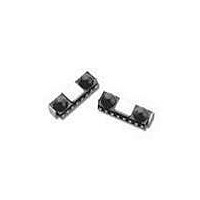HSDL-3201#008 Lite-On Electronics, HSDL-3201#008 Datasheet - Page 18

HSDL-3201#008
Manufacturer Part Number
HSDL-3201#008
Description
Infrared Transceivers IR Transceiver 115.2Kb/s
Manufacturer
Lite-On Electronics
Type
TX/RXr
Datasheet
1.HSDL-3201008.pdf
(20 pages)
Specifications of HSDL-3201#008
Wavelength
875 nm, 880 nm
Continual Data Transmission
115.2 Kbit/s
Transmission Distance
30 cm
Radiant Intensity
9 mW/sr
Half Intensity Angle Degrees
30 deg to 60 deg
Pulse Width
2.45 us, 1.6 us
Maximum Rise Time
120 ns, 600 ns
Maximum Fall Time
80 ns, 600 ns
Led Supply Voltage
2.7 V to 6 V
Operating Voltage
2.7 V to 3.6 V
Maximum Operating Temperature
+ 85 C
Minimum Operating Temperature
- 25 C
Dimensions
8 mm x 3 mm x 2.5 mm
Data Rate
115.2Kbps
Peak Wavelength
875/880nm
Angle Of Half Sensitivity
60/30°
Communication Distance
30
Package Type
Ultra Small Profile
Fall Time
600/25ns
Rise Time
600/20ns
Operating Supply Voltage (typ)
3.3V
Operating Supply Voltage (min)
2.7V
Operating Supply Voltage (max)
3.6V
Mounting
Surface Mount
Pin Count
8
Operating Temp Range
-25C to 85C
Operating Temperature Classification
Commercial
Lead Free Status / Rohs Status
Compliant
Available stocks
Company
Part Number
Manufacturer
Quantity
Price
Shape of the Window
From an optics standpoint, the
window should be flat. This ensures
that the window will not alter either
the radiation pattern of the LED, or
the receive pattern of the photodiode.
If the window must be curved for
mechanical design reasons, place a
curve on the back side of the window
that has the same radius as the front
side. While this will not completely
eliminate the lens effect of the front
curved surface, it will reduce the
effects. The amount of change in the
radiation pattern is dependent upon
the material chosen for the window,
the radius of the front and back
curves, and the distance from the
back surface to the transceiver. Once
these items are known, a lens design
can be made which will eliminate the
effect of the front surface curve.
The following drawings show the
effects of a curved window on the
radiation pattern. In all cases, the
center thickness of the window is 1.5
mm, the window is made of
polycarbonate plastic, and the
distance from the transceiver to the
back surface of the window is 3 mm.
18
Flat Window
(First choice)
Curved Front, Flat Back
(Do not use)
Curved Front and Back
(Second choice)





















